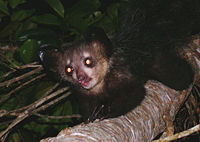Animalia: Difference between revisions
Jump to navigation
Jump to search

imported>Dalton Holland Baptista (Adding taxobox) |
imported>Dalton Holland Baptista No edit summary |
||
| Line 14: | Line 14: | ||
See text | See text | ||
}} | }} | ||
'''Animalia''' also called ''Metazoa'' is the [[taxonomy|taxonomic]] kingdom which includes all [[animal]]s. All animals are multi-cellular, with the cells enclosed in [[membrane]]s and | '''Animalia''' also called ''Metazoa'' is the [[taxonomy|taxonomic]] kingdom which includes all [[animal]]s. All animals are multi-cellular, with the cells enclosed in [[membrane]]s and organized in a complex manner; almost all can move on their own, and all rely on eating other organisms in order to sustain their [[life|lives]]. [[Human]]s are include in the ''animalia'' kingdom biologically (we are [[mammal]]s, we belong to the [[phylum]] (the next division) [[chordata]]) but in everyday speech humans are not generally spoken of as animals. | ||
Revision as of 18:18, 10 March 2009
| Aye-aye | ||||
|---|---|---|---|---|
 Aye-aye, photo by Tom Junek.
| ||||
| Scientific classification | ||||
| ||||
| Phyla | ||||
|
See text |
Animalia also called Metazoa is the taxonomic kingdom which includes all animals. All animals are multi-cellular, with the cells enclosed in membranes and organized in a complex manner; almost all can move on their own, and all rely on eating other organisms in order to sustain their lives. Humans are include in the animalia kingdom biologically (we are mammals, we belong to the phylum (the next division) chordata) but in everyday speech humans are not generally spoken of as animals.